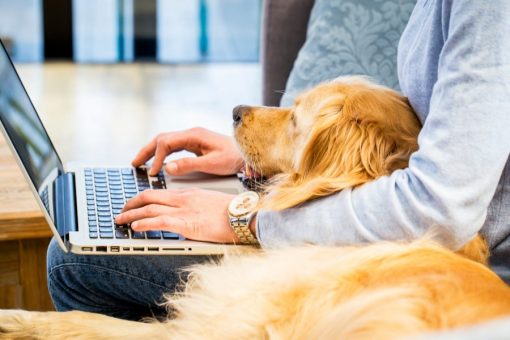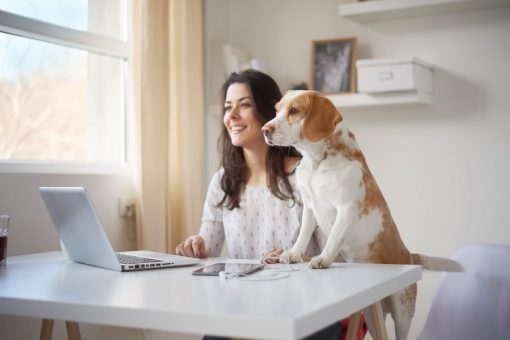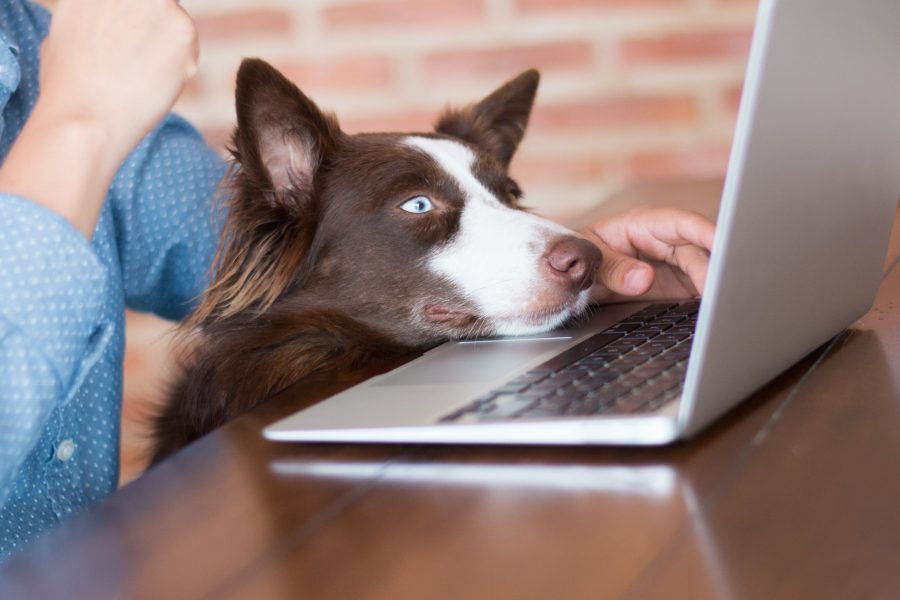Have you ever wanted to take your pet to work? There is a specific day for this!
The so-called International Take your Dog to Work Day was conceived in 1996 in Great Britain and has been spreading worldwide – first in the United States and then throughout Europe – as an international occurrence.
The Take your Dog to Work Day takes place each year at the end of June.
There is no fixed day simply because from year to year the days shift position and during the weekends many people do not work.
On this day people take their four-legged friends to their workplace, thus avoiding the problems that generally arise when dogs – both puppies and adult dogs – have to be left alone at home.
Bringing your dog to the office seems to be beneficial for all parties involved.
In fact, not only does it make our pets happier because they are with us, but – according to different studies – it is also a good way for their owners to relieve the stress.
If you work in a pet-friendly office, you do not have to leave your dog alone at home.

For the past twenty years more and more companies have been allowing workers to take their pets with them on days other than the International Dog Day – provided they respect the dog regulations at the office.
If you want to bring your dog to your office, here are some simple rules you have to follow to avoid inconveniences in the workplace and to make this experience enjoyable for everyone:
- Objectively assess your dog’s attitude: it goes without saying that, if your dog is docile, quiet and friendly, none of you will have any problems in the workplace. However, if your dog has a completely opposite disposition, then he will tend to disturb you and those around you during the workday – he may even bark at other dogs and try to attack them;
- In order to get your pet used to staying at your office, you have to do it gradually. Start with a few hours a day at a time;
- Always keep with you the tools that may help you keep your pet under control, even if you think they are useless. It is required by law to have at least his leash and his muzzle;
- Take your dog for a walk during your break: dogs love to be taken by their owners outside and it also gives them the opportunity to relieve themselves. Moreover, it is also a good chance for you to stretch your legs and relax.
How to Teach your Dog to Stay Home Alone for 8 Hours
Leaving your dog alone at home for 8 hours can be a problem for both you and your pet. In fact, strange as it may seem, dogs perceive time as humans!
Leaving a pet alone at home for 10 hours – if one considers commuting as well – may make owners feel guilty and may also have some negative effect on dog’s behaviour.
It may have happened to everyone to come across friends and colleagues who complain that their pets destroy their furniture when they are left alone.

Well, we certainly wouldn’t want that to happen to us – assuming that you have not already experienced such situation first hand.
Many prefer to accustom their dogs to being alone at home by seeking for advice on forums and blogs dedicated to this subject.
Other people prefer simply to not overthink it and they keep returning home late at night hoping nothing has happened both to their pets and their furniture.
Getting your dog used to being alone at home may not be the best alternative.
However, for the sake of both you and your pet, here are some tips found on the net which will help you to accustom your dog to staying alone at home:
- Prevent your dog from following you everywhere, otherwise this will become a habit for him. Leaving him alone in a room – without giving in to the temptation to open the door after a few seconds – might help him understand that even if you are not in the same room, you are present;
- When the time comes for you to go out, avoid giving him any attention and talking to him because, since he does not understand what you are telling him, he may conclude that you are punishing him by staying out for a long time. Wait until you come home at the end of the day to let him fawn on you. When you get back home, wait until you receive his attention, then let several minutes pass before you start pampering your pet. This will make your dog understand that your absence is not a punishment but just a normal thing.
Leaving your Dog Alone at Home
Sooner or later, all dog owners will inevitably face the possibility of leaving a dog alone at home.
First of all, you should be aware that teaching your pet to get used to your absence requires a lot of patience.
However, it is important to distinguish between two cases.
In the first case your pet is a puppy that you have just welcomed into your home and now you are wondering how could you ever leave him alone at home.
In the second case you are dealing with an adult dog, which complicates things.
In fact, when your dog is young it is easier to gradually get him used to your absence, without it causing him too much stress.
When a puppy arrives in his first home, he probably has never experienced loneliness, as he has always been surrounded by his mother and his siblings.
Moreover, in the wild, no member of the pack is left behind during migration.
Therefore, dogs do not understand how a member of their pack (i.e. their owners) could ever abandon them – even if only for a short period of time.
For this reason, it is necessary to educate the puppy through training sessions.
Start by leaving the room in which he is – perhaps while he is busy with a new game – for a few minutes.
Then you may leave the house, making sure you maintain a relaxed attitude before you leave and when you return.
If your puppy barks or gets upset, do not indulge him while you are outside the house or you will end up making him even more anxious.
Wait until he is calm again and get back in. This will make him understand that “calling you” by barking is not the right way to get you back home.
If you have to deal with an adult dog, however, leaving him home alone is slightly more complicated.
In fact, the innate belief that no member of the pack should be left behind is already deeply rooted in him.
Therefore, if he finds himself suddenly alone his anxiety will go through the roof. You could start by staying away from your pet for short periods of time and by gradually increasing the length of your absence.
Do not forget to always show yourself calm and detached while leaving.
Do not reward the dog with sweets or words of comfort when leaving the house, otherwise he will think that you are going to leave for a very long time or that something terrible is going to happen, since you feel the need to comfort him.

Similarly, keep a relaxed expression when you return home: this will allow your dog to experience your absence as a normal event.
Animals in the Workplace
Office workers run the risk of suffering from what is called work-related stress.
As a result, it is important to understand what it is about and how we can tell if we are affected by this condition.
If you feel like you may have run into work-related stress, you can check if you have one of the following symptoms:
- Absenteeism
- Interpersonal difficulties in the workplace
- Insecurity
- Impulsiveness
- Increased tendency to make mistakes
- Anxiety
- Depression
- Pessimism
In order to solve this problem, more and more companies, both in Italy and abroad, are experimenting with the introduction of animals in the office.
In other words, these companies are allowing their employees to bring their pets in the workplace.
In fact, many studies have shown that having the opportunity to work with your pet reduces anxiety, insecurity and stress caused by work.
This is because dogs encourage a serene and cohesive atmosphere in the workplace.
They help workers develop team spirit and feel like they are in a less formal setting.
In addition, if they are allowed to bring dogs in their office, the workers will stop feeling guilty about leaving their pets home alone and start becoming more productive.
Many studies claim that employees who have the chance to spend time at work with their pets show lower levels of stress.
Moreover, a pet-friendly office helps create a healthy balance between work and private life, thus increasing the serenity of employees as well as corporate productivity.
In reality, however, it is not so simple to implement such a solution. Bringing pets in the office, in fact, requires precautions and adequate space, for the sake of both dogs and workers.
First of all, in pet-friendly companies dog owners are recommended – not to say required – to take out insurance against damage to third parties, to be protected in every case.
Moreover, it may be necessary to provide an appropriate separate space, which could meet the owners’ and pets’ needs.
More breaks could also be necessary to allow both workers and their pets to stretch their legs – thus avoiding the presence of unsettled animals in the offices.
Pets and Stress
Many studies have shown that pets reduce stress in the workplace. This has already been established for several years now.
Bringing your pet along in order to reduce stress seems to be a good solution for all parties involved.
First of all, owners will not feel guilty for having abandoned – even if only temporarily – their dogs at home.
They would immediately feel relieved to have their pets with them. Moreover, they would not spend all day worrying about their dogs feeling abandoned and about them making trouble for spite.
As a result, workers would be able to focus on their work without getting distracted by such thoughts.
Secondly, it has been proven that dogs in the office also increase productivity both in their owners and in the other employees.
In fact, they feel the good vibes emanated by the dog owner bond and tend, by human nature, to empathise with this feeling.
The most important values that dogs carry with them are friendship, trust and loyalty and this helps create a more relaxed and rich in positive vibrations atmosphere .
